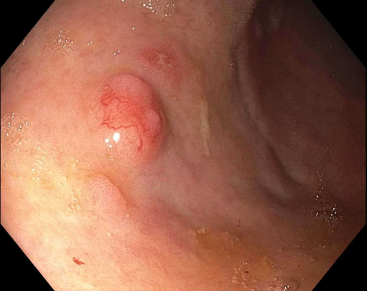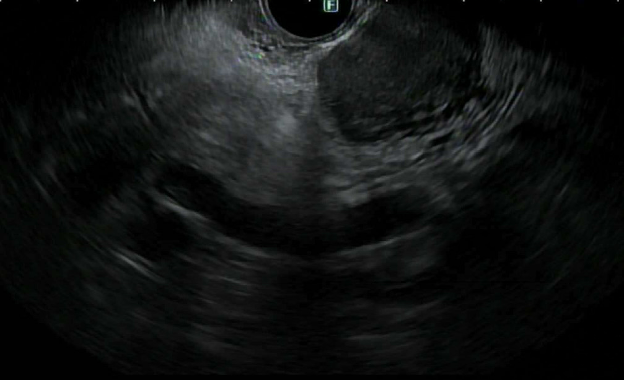Sunday Poster Session
Category: Stomach and Spleen
P2083 - Rare Case of Low-Grade Metastatic Type 1 Gastric Neuroendocrine Tumor
Sunday, October 26, 2025
3:30 PM - 7:00 PM PDT
Location: Exhibit Hall

Ronan Allencherril, MD
Houston Methodist Hospital
Houston, TX
Presenting Author(s)
Ronan Allencherril, MD, Thomas R. McCarty, MD, MPH
Houston Methodist Hospital, Houston, TX
Introduction: Type 1 gastric neuroendocrine tumors (NET) are the most common NET subtype and generally have a favorable prognosis. Although rates of recurrence are high, metastatic disease is quite rare with a typically indolent course. These tumors are slow to progress and can often be managed conservatively. Here we present a unique case of a type 1 gastric NET presenting with recurrence and metastatic disease.
Case Description/
Methods: A 65-year-old gentleman with a history of type 1 gastric NET, diabetes, and end stage renal disease for work-up for incidental lymphadenopathy noted on imaging as work-up for renal transplant evaluation. The patient was initially diagnosed with type 1 gastric NET in 1999 when he underwent an esophagogastroduodenoscopy (EGD) showing a gastric polyp which was then resected. Pathology showed a gastric carcinoid tumor, and he subsequently underwent a non-oncological surgical resection of the remainder of the tumor. He did not have follow-up or surveillance imaging for several years. In 2024, he had nausea, vomiting and diarrhea, prompting an emergency visit where a computed tomography (CT) scan showed nonspecific gastrohepatic lymphadenopathy. A positron emission tomography scan showed similar lymphadenopathy with uptake in the gastric antrum and pylorus as well as two lesions in the liver. He subsequently an EGD showing multiple gastric polypoid lesions (Figure 1). Endoscopic mucosal resection of largest lesion was performed with two clips were placed for hemostasis. Endoscopic ultrasound (EUS) visualized several enlarged gastrohepatic ligament lymph nodes, up to 26 mm in length (Figure 2) with fine needle biopsy (FNB) performed. Pathology from both the lymph node and gastric polyp showed well-differentiated, grade 1 neuroendocrine tumor, with associated atrophic gastritis on mucosal biopsies. He has since established with oncology, and although the patient is asymptomatic, he is pending treatment for the NET to improve the likelihood of renal transplant candidacy.
Discussion: This is a unique case of a low-grade, metastatic type 1 NET. Although this tumor subtype generally follows a less aggressive disease course, this case highlights the importance of surveillance, nonetheless. As the patient was lost to follow-up, we suspect smoldering disease over the past 20 years since the initial diagnosis.

Figure: Figure 1: Endoscopic appearance of gastric polypoid lesion found to be a low-grade type 1 gastric neuroendocrine tumor (NET).

Figure: Figure 2: Endosonographic appearance of 26 mm gastrohepatic lymph node found to be a metastatic type 1 gastric neuroendocrine tumor (NET)..
Disclosures:
Ronan Allencherril indicated no relevant financial relationships.
Thomas McCarty: Covidien/Medtronic – Consultant. Endoquest Robotics – Consultant.
Ronan Allencherril, MD, Thomas R. McCarty, MD, MPH. P2083 - Rare Case of Low-Grade Metastatic Type 1 Gastric Neuroendocrine Tumor, ACG 2025 Annual Scientific Meeting Abstracts. Phoenix, AZ: American College of Gastroenterology.
Houston Methodist Hospital, Houston, TX
Introduction: Type 1 gastric neuroendocrine tumors (NET) are the most common NET subtype and generally have a favorable prognosis. Although rates of recurrence are high, metastatic disease is quite rare with a typically indolent course. These tumors are slow to progress and can often be managed conservatively. Here we present a unique case of a type 1 gastric NET presenting with recurrence and metastatic disease.
Case Description/
Methods: A 65-year-old gentleman with a history of type 1 gastric NET, diabetes, and end stage renal disease for work-up for incidental lymphadenopathy noted on imaging as work-up for renal transplant evaluation. The patient was initially diagnosed with type 1 gastric NET in 1999 when he underwent an esophagogastroduodenoscopy (EGD) showing a gastric polyp which was then resected. Pathology showed a gastric carcinoid tumor, and he subsequently underwent a non-oncological surgical resection of the remainder of the tumor. He did not have follow-up or surveillance imaging for several years. In 2024, he had nausea, vomiting and diarrhea, prompting an emergency visit where a computed tomography (CT) scan showed nonspecific gastrohepatic lymphadenopathy. A positron emission tomography scan showed similar lymphadenopathy with uptake in the gastric antrum and pylorus as well as two lesions in the liver. He subsequently an EGD showing multiple gastric polypoid lesions (Figure 1). Endoscopic mucosal resection of largest lesion was performed with two clips were placed for hemostasis. Endoscopic ultrasound (EUS) visualized several enlarged gastrohepatic ligament lymph nodes, up to 26 mm in length (Figure 2) with fine needle biopsy (FNB) performed. Pathology from both the lymph node and gastric polyp showed well-differentiated, grade 1 neuroendocrine tumor, with associated atrophic gastritis on mucosal biopsies. He has since established with oncology, and although the patient is asymptomatic, he is pending treatment for the NET to improve the likelihood of renal transplant candidacy.
Discussion: This is a unique case of a low-grade, metastatic type 1 NET. Although this tumor subtype generally follows a less aggressive disease course, this case highlights the importance of surveillance, nonetheless. As the patient was lost to follow-up, we suspect smoldering disease over the past 20 years since the initial diagnosis.

Figure: Figure 1: Endoscopic appearance of gastric polypoid lesion found to be a low-grade type 1 gastric neuroendocrine tumor (NET).

Figure: Figure 2: Endosonographic appearance of 26 mm gastrohepatic lymph node found to be a metastatic type 1 gastric neuroendocrine tumor (NET)..
Disclosures:
Ronan Allencherril indicated no relevant financial relationships.
Thomas McCarty: Covidien/Medtronic – Consultant. Endoquest Robotics – Consultant.
Ronan Allencherril, MD, Thomas R. McCarty, MD, MPH. P2083 - Rare Case of Low-Grade Metastatic Type 1 Gastric Neuroendocrine Tumor, ACG 2025 Annual Scientific Meeting Abstracts. Phoenix, AZ: American College of Gastroenterology.
